Hidden Netflix Gems: Once Upon a Time in the West
This week’s Hidden Netflix Gem: “Once Upon a Time in the West” (1968)
It’s 2012, so it wouldn’t be all that surprising to discover a majority of young people have not heard of Italian film director, producer, and screenwriter Sergio Leone. After all, the man died 23 years ago in 1989. However, you’d likely be hard pressed to find someone in that demographic who hasn’t seen, or at the very least heard of the man’s work.
Leone, one of the most prominent figures of the Spaghetti Western sub-genre, released his first film, “The Last Days of Pompeii,” in 1959 and his last, “Once Upon a Time in America,” in 1984. But it was during the 1960s that a number of his most popular films, those that remain relevant to this day, were released. Firstly, there’s the Dollars Trilogy, a series of three films which Leone wrote and directed which followed the exploits of the “Man with No Name,” played by Clint Eastwood. There’s a name you’ve heard, Clint Eastwood, and I bet you’ve heard of the trilogy’s final installment as well, 1966’s “The Good, the Bad and the Ugly.”
After the Dollars Trilogy was completed, Leone decided he was done with Westerns. He’d said all he wanted to within the confines of the genre. It was only after Paramount informed Leone that he’d have access to Henry Fonda—his favorite actor, one he’d wanted to work with his entire career—that he decided to return. Leone and his fellow writers spent nearly a year watching and discussing some of the best American Westerns to date before constructing a story made up almost entirely of references to those classics.
Problem was, around the same time, Henry Fonda had decided he was done with Westerns too, and turned down Leone’s first offer to star in “Once Upon a Time in the West.” It wasn’t until Leone flew to New York to meet with Fonda in person that the actor accepted. To convince him, Leone said, “Picture this: the camera shows a gunman from the waist down pulling his gun and shooting a running child. The camera tilts up to the gunman’s face and…it’s Henry Fonda.” See, Fonda had spent most of his career playing good guys. But in “Once Upon a Time in the West,” he was cast against type, playing not just a bad guy, but one of the most sadistic, monstrous villains ever to grace the silver screen.
Now that all that background’s out of the way, I suppose we should talk about the film itself. Contrary to the fast-paced, upbeat nature of previous Westerns, the film includes numerous long, drawn-out shots and scenes with little dialogue and less action significant to the over-arching plot. These scenes of quiet are often interrupted by sudden outbreaks of violence. It’s the quiet, the routine, and then bam: sound and fury. The film is less a study of violence and more about the subtleties that precede it.
The film begins with the arrival of a quiet man known only as Harmonica, played by Charles Bronson (the Charles Bronson, the one from whom that other guy took his “fighting name”). “Instead of talking, [Harmonica] plays. And when he better play, he talks.” For reasons unknown to the viewer, Harmonica is on a mission of vengeance against the villainous Frank (Fonda), who works as something of an enforcer for railroad tycoon Morton (Gabriele Ferzetti). As mentioned, the first time we see Frank, he’s massacring an innocent family, the McBains, for reasons equally unknown. Frank tries to pin the blame for the killings on a local outlaw named Cheyenne (Jason Robards). When Cheyenne hears this, he and Harmonica become uncertain allies in a war against Frank. They’re joined by Jill (Claudia Cardinale), a young woman who’d travelled out west from New Orleans to marry the recently deceased McBain.
Part of what makes the film special is its twisting of the genre’s many tropes. For example, Cheyenne is one of the film’s more honorable and likable characters. The fact that he robs people for a living is irrelevant. But the biggest and most interesting of these aversions is that it’s never assured that Harmonica will be capable of killing Frank and getting his vengeance. He’s wounded in the film’s first scene, and as a result, he’s clearly far from invincible. This is not the smooth ride of the overly-lovable sheriff defeating the bank robber. Whether or not the “good guys” can win is never a foregone conclusion. It wouldn’t be in the real world, so it’s not in “Once Upon a Time” either. Furthermore, horrible as Frank may be, it’s hard not to respect him. The first parallel that springs to mind is Darth Vader. Sure he’s the bad guy, but he’s also a badass.
“Once Upon a Time in the West” is long, with a running time of 165 minutes, and the drawn-out style will no doubt be foreign to contemporary viewers. But there’s a reason the film gets all the accolades it receives. It sits at a 98 percent on the Tomatometer, and is generally acknowledged as one of the best Westerns ever made. In 2009, it was placed in the National Film Registry in the Library of Congress for being “culturally, historically or aesthetically” significant. Consistently quotable, with a number of intriguing conflicts and sub-conflicts, taking in “Once Upon a Time in the West,” one of the great masterpieces of the 20th century, is a more than worthwhile way to spend your Saturday evening.
Check out the trailer below and follow the writer on Twitter @NateKreichman.
It’s Saturday night and you need something to watch. Never fear, Hidden Netflix Gems is a weekly feature designed to help you decide just what it should be, and all without having to scroll through endless pages of crap or even leave the house. Each choice will be available for streaming on Netflix Instant, and the link below will take you to its page on the site. Look for a new suggestion here every Saturday.
Related Posts
Comments Off on Hidden Netflix Gems: Once Upon a Time in the West
Posted in: Entertainment, Movies
Tags: Charles Bronson, Cheyenne, Claudia Cardinale, Clint Eastwood, Dollars Trilogy, Frank, Gabriele Ferzetti, harmonica, Henry Fonda, Hidden Netflix Gems, Jill McBain, Morton, Nate Kreichman, old west, Once Upon a Time in the West, railroad, Sergio Leone, Spaghetti Western, Staff Picks - Movies, tycoon, Western









